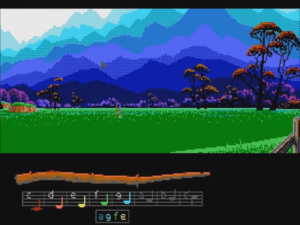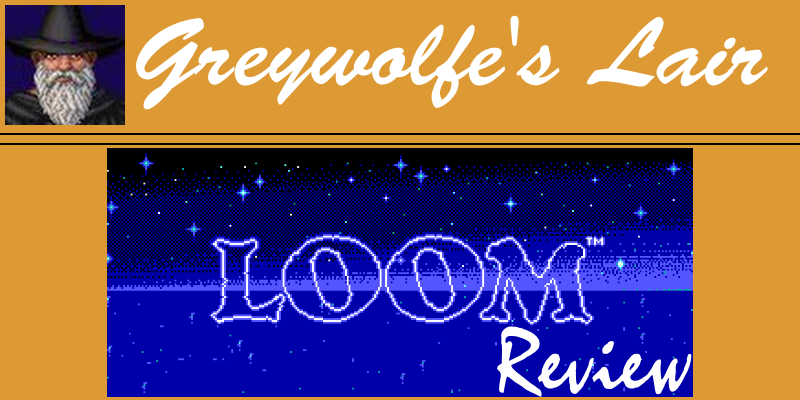Sometimes, a game comes along that does something extra-ordinary.
Before you play it, you can't help but wonder if you're going to like it - exactly because of it's differences - but once you have played it, you see the world just a little bit differently. The game opens new possibilities, new vistas.
Loom's story isn't wholly original, but given it's run time and the themes it's trying to convey to the player, that's just fine. What is masterful is the way it presents this story.
Loom starts with an audio drama. You'd get the game box, open it up and there, nestled inside the box - along with the game disks and other paraphernalia - was a cassette tape. This - when listened to - introduced you to the world of Loom, the Age of the Guilds and the idea of weaving.
Weaving is a pretty central concept to Loom itself, but I'll talk about that more in a minute.
Once you got through the audio drama, it was very important to read the Book of Patterns - a book that contained notes about various weaves that you might encounter throughout the game. A weave - or a draft - as they're more commonly called - is a short song - four notes that you sing - to your distaff. Your distaff is a focus that, when pointed at an object - will do something based on the song you sing.
If you sing the "Song of Opening" then the door in front of you swings open. If you sing the "Song of Light" then any dark area surrounding you will be bathed in light.
And this, really, is the central premise for Loom and what makes it stand, head-and-shoulders, almost - over most adventure games of the era. Between the distaff being the means to solving all the puzzles and all the puzzles being almost completely logical, Loom was a game designed to be finished and designed so that you saw the entirety of the story.

This purposeful design choice is seen everywhere - from the gentle visuals, making the game [at least in the first half] a very pastoral, very serene experience - all the way through to the music [fine reworks of Swan Lake done by George Sanger, who some might recognize as "The Fat Man" - the composer responsible for the Seventh Guest soundtrack.]
Music is very central to Loom, and picking Swan Lake, here is pivotal, because much of the plot revolves around a young Weaver named Bobbin, who was pulled from the Loom by Lady Cygna Threadbare. Bobbin, it turns out, is a source of great distress for the Elders of Loom island, because they're worried that he is the herald of chaos.
Swan Lake is pretty instrumental here [if you'll pardon the pun] because it serves the plot well in several respects. As chaos descends on Loom island, all the Elders are turned to swans, themselves. Only Bobbin is spared this fate, and it is up to him to find the rest of his Guild so that he can join them - wherever they are.
Once most of this plot is taken care of, you actually start off playing the game - and it is here that Loom distinguishes itself. As I said earlier, the game revolves around the distaff. There is no "verb interface" for Loom. Once you pick up your distaff, you are given a list of notes that you can play. If the note is colourful, then you know it. If the note is dull grey, you can still hear it being played, but you do not have the ability to spin [common Loom parlance for "playing" or "singing" a note] that particular "thread."
Each time you encounter a puzzle, you will more-than-likely be able to solve it just by looking at the repertoire of songs you know. For example, let's pretend you learned a Fire draft. If, in the game world, you stopped to camp, you might set up camp by finding a bunch of sticks, putting them all together in an arrangement that will burn nicely and then simply sing the "Song of Fire" to get them going.

You pick up songs in the wild, generally by pointing your distaff at an item or by hearing the song sung by someone else. So, for example, you might hear someone humming the "Song of Sock Folding" and - if you're canny and write this down - you will be able to cast that particular draft on your own socks when you need to do your laundry.
This particular method of solving puzzles is absolutely genius. There's very little muddling around with what to do, because - for the most part, the puzzles are all logical. It's also incredibly thematic, tying everything together rather well - from the world building of the audio drama all the way through to the wonderful world Loom sets up.
But there are a couple of quibbles. The VGA remake strips many lines of text from dialogue with other people, also opting to do away with much of the incidental music and some sounds in favour of a very well rendered talkie version. This VGA edition also does away with incidental portraits for talking characters. If at all possible, I do not recommend the VGA version - which - while superior in terms of graphics, does so many other things wrong.
![The antagonists [well, everyone that isn't a "main character" in Loom, really] get incredibly short shift. People who should have been thoughtful and meaningful are - unfortunately and probably mostly because of disk space - reduced to stereotypes.](http://twinstiq.com/wp-content/uploads/2016/07/loom_scary_dude-300x225.png)
Finally, it must be said that the latter half of the game feels a little rushed - the tone almost immediately shifting form a gentle stroll to a terrifying and dark nightmare within the space of one encounter.
Loom is beautiful and elegant and a very fresh take on a genre that had been struggling for fresh takes for a decade, by this point. The sequel to Loom [purportedly called Forge] never saw the light of day, and the world is kind of darker for it.
So, would I recommend this game? Wholeheartedly and unreservedly. Loom is a quality game with an absolutely visceral user experience that puts you right into the centre of the story. It has a very compelling world, very interesting characters, [when they're fleshed out] beautiful graphics and a wonderful score.
Twenty five years on, it is still a precious gaming treasure and an absolute work of art.
I did a Let's Play of the EGA version of Loom here.
Twinstiq played this for the rebooted Game Club. You can read the introduction post for that here.

